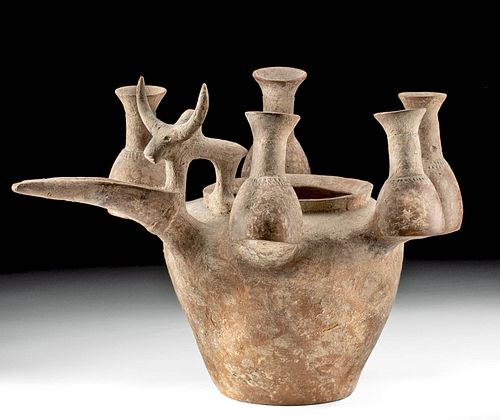9th C. Tepe Siaulk Pottery Jar w/ Zebu , ex-Sotheby's
Lot 63a
About Seller
Artemis Fine Arts
686 S Taylor Ave, Ste 106
Louisville, CO 80027
United States
Selling antiquities, ancient and ethnographic art online since 1993, Artemis Gallery specializes in Classical Antiquities (Egyptian, Greek, Roman, Near Eastern), Asian, Pre-Columbian, African / Tribal / Oceanographic art. Our extensive inventory includes pottery, stone, metal, wood, glass and textil...Read more
Categories
Estimate:
$3,000 - $4,500
Absentee vs Live bid
Two ways to bid:
- Leave a max absentee bid and the platform will bid on your behalf up to your maximum bid during the live auction.
- Bid live during the auction and your bids will be submitted real-time to the auctioneer.
Bid Increments
| Price | Bid Increment |
|---|---|
| $0 | $25 |
| $300 | $50 |
| $1,000 | $100 |
| $2,000 | $250 |
| $5,000 | $500 |
| $10,000 | $1,000 |
| $20,000 | $2,500 |
| $50,000 | $5,000 |
| $100,000 | $10,000 |
| $200,000 | $20,000 |
About Auction
By Artemis Fine Arts
Oct 8, 2020
Set Reminder
2020-10-08 10:00:00
2020-10-08 10:00:00
America/New_York
Bidsquare
Bidsquare : Exceptional Antiquities, Asian, Ethnographic
https://www.bidsquare.com/auctions/artemis-gallery/exceptional-antiquities-asian-ethnographic-5796
Museum-worthy examples of Egyptian, Greek, Roman, Etruscan, Near Eastern, Far East / Asian, Pre-Columbian, African / Tribal,Oceanic, Native American, Spanish Colonial, Russian, Fossils, Ancient Jewelry, Fine Art, so much more! Artemis Fine Arts info@artemisfinearts.com
Museum-worthy examples of Egyptian, Greek, Roman, Etruscan, Near Eastern, Far East / Asian, Pre-Columbian, African / Tribal,Oceanic, Native American, Spanish Colonial, Russian, Fossils, Ancient Jewelry, Fine Art, so much more! Artemis Fine Arts info@artemisfinearts.com
- Lot Description
Ancient Near East, southwestern Caspian Sea region, northern Iran, Tepe Siaulk (also Tepe Sialk), ca. 9th to late 8th century BCE. A beautiful, hand-built pottery jar featuring an inverted piriform body atop a flat base, a rounded shoulder, and a flared vertical rim. The front of the vessel exhibits a narrow, beaked spout surmounted by a highly stylized zebu bull with a grand pair of horns, and a quintet of subsidiary vessels protrudes from the shoulder and showcases faintly pecked patterns around their respective shoulders. Faded remains of red-orange and white pigment indicate just how ornate this vessel would have looked when first created. Size: 12.375" W x 11.625" H (31.4 cm x 29.5 cm)
Cf. Sotheby's, Erlenmeyer Collection (Part I), no. 247
Provenance: private New York, New York, USA collection; ex-Sotheby's, New York "Antiquities and Islamic Art" auction (June 4, 1998, lot 200); ex-private New York, New York, USA collection, acquired between the 1970s and 1990s
All items legal to buy/sell under U.S. Statute covering cultural patrimony Code 2600, CHAPTER 14, and are guaranteed to be as described or your money back.
A Certificate of Authenticity will accompany all winning bids.
We ship worldwide and handle all shipping in-house for your convenience.
#159199Repaired from multiple pieces with resurfacing and overpainting along break lines. Nicks and abrasions to base, body, spout, zebu, and subsidiary vessels, with light encrustations, softening to some pecked motifs on smaller vessels, and fading to original pigment. Nice earthen deposits and light remains of original pigment throughout.Condition
- Shipping Info
-
All shipping is handled in-house for your convenience. Your invoice from Artemis Gallery will include shipping calculation instructions. If in doubt, please inquire BEFORE bidding for estimated shipping costs for individual items.
-
- Buyer's Premium



 EUR
EUR CAD
CAD AUD
AUD GBP
GBP MXN
MXN HKD
HKD CNY
CNY MYR
MYR SEK
SEK SGD
SGD CHF
CHF THB
THB
















